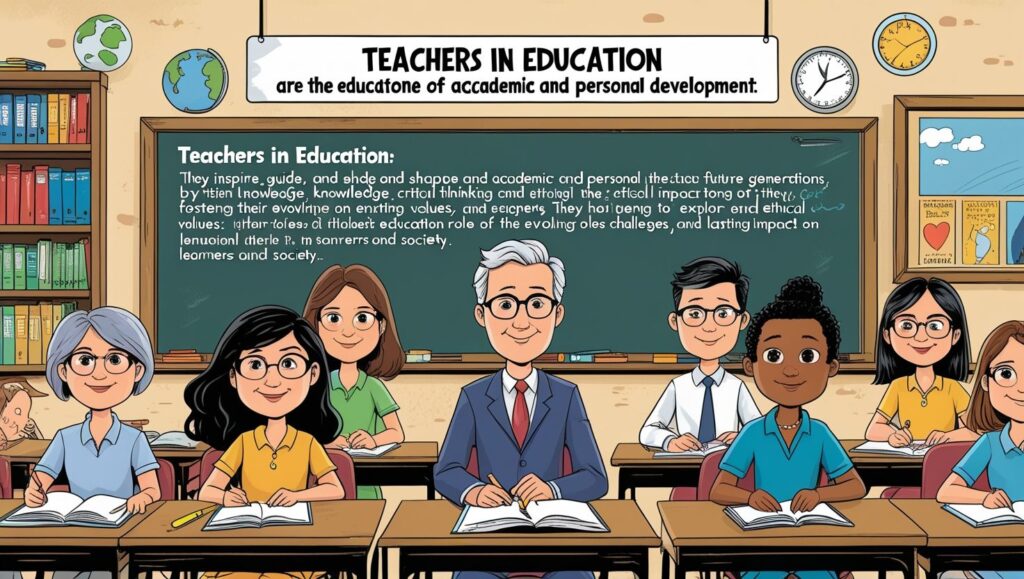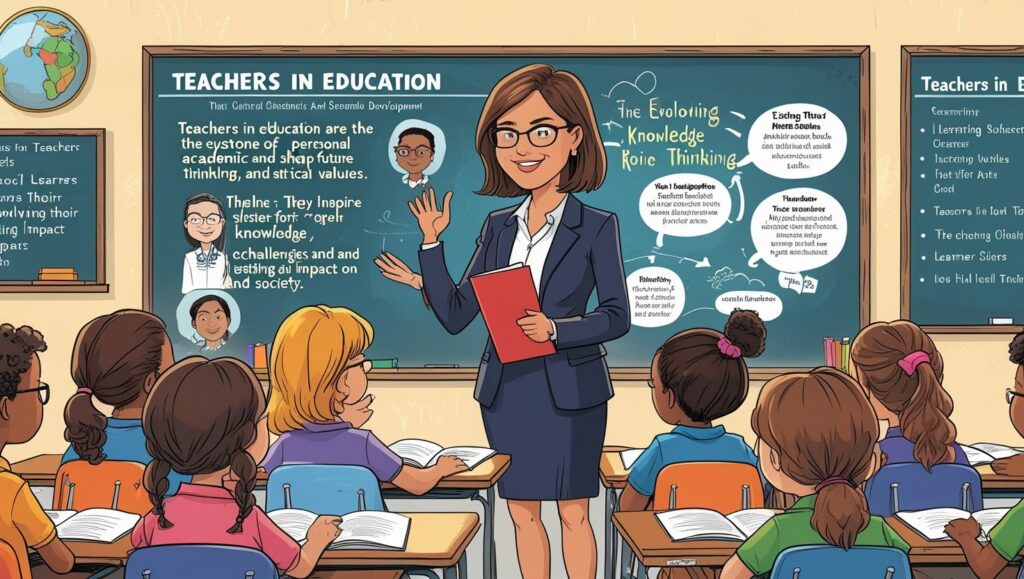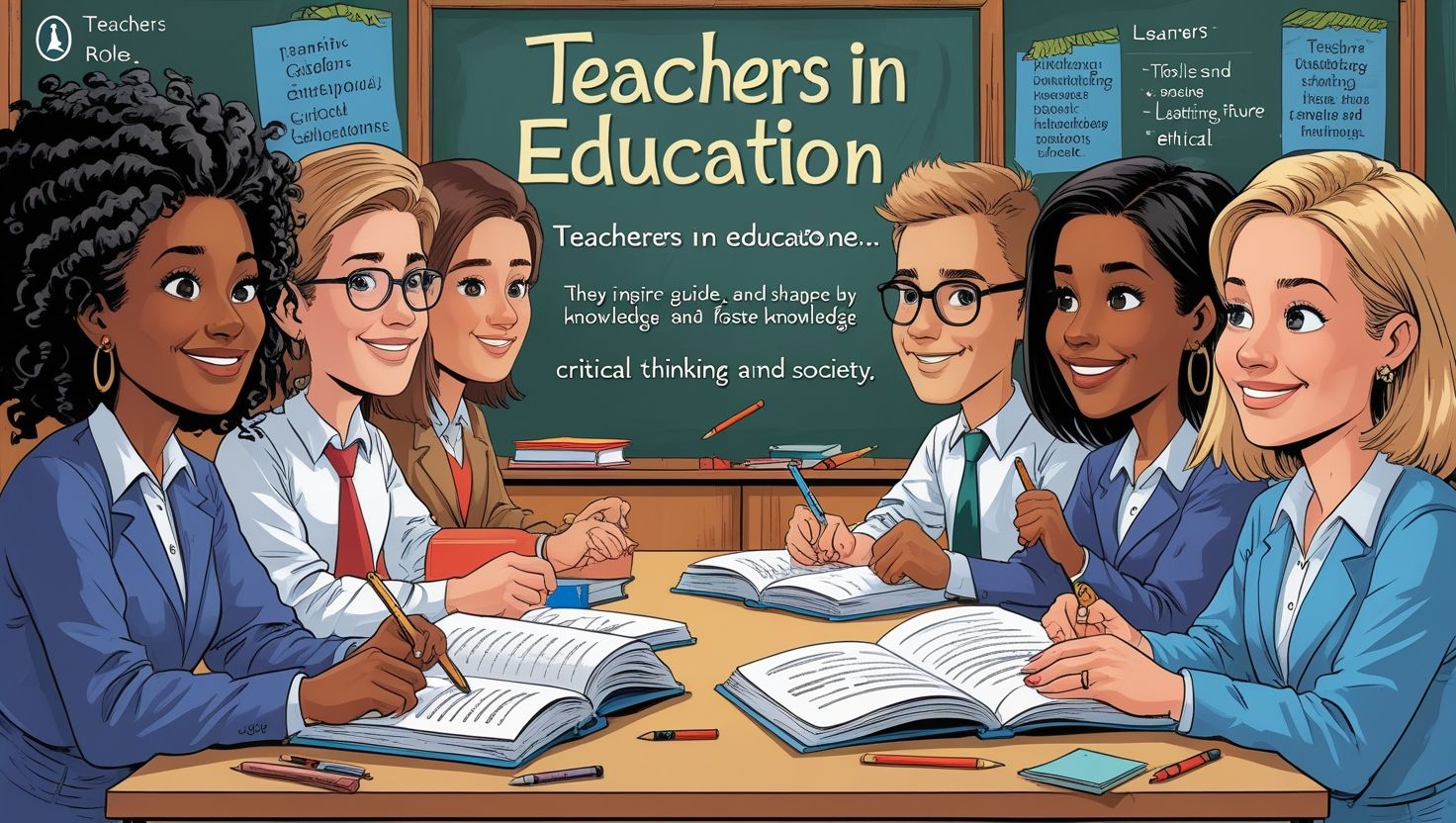1. Introduction: The Pillars of Educational Framework
Teachers in Education, Teachers stand at the heart of the educational system, playing a fundamental role in shaping minds and guiding future generations. Their contribution extends far beyond the classroom; they are mentors, counselors, role models, and catalysts of change. Education, as a transformative process, finds its foundation in the dedication and expertise of teachers who communicate knowledge, values, and critical thinking. In an era where learning modalities and technologies continue to evolve, the constant remains the human touch provided by teachers. From early childhood to higher education, they influence how students perceive themselves and the world around them. A society that values education inevitably reveres its teachers, understanding their critical influence on social development, national progress, and global peace. Recognizing the role of teachers in educational success is essential in crafting policies, developing curricula, and nurturing a learning environment that inspires creativity, inclusion, and lifelong learning. This article delves into the various dimensions of teachers’ contributions, exploring their responsibilities, challenges, development, and the indispensable role they play in modern education systems. Through this discussion, we highlight why investing in teachers is investing in the future of any nation.
2. Historical Perspective of Teachers’ Role in Education
The role of teachers has evolved significantly throughout history. In ancient civilizations like Greece and India, teachers were revered as spiritual and intellectual guides. Philosophers such as Socrates, Confucius, and Chanakya laid the groundwork for educational instruction by emphasizing moral development, inquiry, and reasoning. In medieval times, the church played a central role in education, with clergy serving as primary educators. The industrial revolution brought about formal education systems, and the role of teachers shifted from moral guides to facilitators of structured learning, focusing on literacy, numeracy, and vocational training. The 20th century witnessed progressive movements led by educators like John Dewey, who emphasized experiential learning and the teacher’s role as a facilitator rather than an authoritarian figure. With the digital age, the expectations from teachers expanded further—they are now required to integrate technology, foster critical thinking, and adapt to diverse classrooms. Despite these transformations, the core essence remains unchanged: teachers are pivotal in nurturing knowledge, skills, and ethical values. Understanding this historical evolution helps contextualize the multifaceted responsibilities of modern educators and the need for ongoing support and adaptation in teaching methodologies to meet contemporary educational demands.
3. Qualities of an Effective Teacher
An effective teacher possesses a blend of personal, professional, and interpersonal qualities that collectively create a positive learning environment. Foremost among these is empathy—the ability to understand and respond to the emotional and academic needs of students. Equally important is strong communication, enabling the teacher to convey complex ideas clearly and encourage dialogue. Organization and time management allow for efficient lesson planning and classroom management, fostering a structured yet flexible learning space. Passion for the subject and a continuous desire to learn contribute to staying updated with new content and pedagogical methods. Furthermore, adaptability is crucial in accommodating diverse learning styles and integrating technology effectively. Patience, fairness, and consistency build trust and respect among students. A good teacher is also a reflective practitioner, continuously assessing their own methods and seeking feedback for improvement. Beyond academic instruction, effective teachers inspire confidence, motivate students to exceed their potential, and instill lifelong learning habits. Their enthusiasm can transform a passive classroom into a vibrant intellectual community. These qualities, when cultivated and supported, make teachers not just conveyors of knowledge but mentors who shape the character and aspirations of their students.
4. Teacher as a Facilitator of Learning
In modern pedagogy, the teacher is no longer seen solely as a source of knowledge but as a facilitator of learning. This shift represents a significant evolution in educational philosophy, emphasizing student-centered learning over traditional lecture-based instruction. A facilitator encourages active participation, inquiry, collaboration, and critical thinking. They design engaging learning experiences that cater to varied learning styles and foster autonomy among students. Instead of dictating information, they pose questions, stimulate discussions, and guide students in exploring and constructing knowledge. This approach empowers learners to take ownership of their education, leading to deeper understanding and long-term retention. Additionally, a facilitating teacher integrates multimedia tools, real-world applications, and cross-disciplinary connections to enhance relevance and engagement. Creating a supportive environment where students feel safe to express themselves, make mistakes, and learn from them is a key aspect of facilitation. This model also requires the teacher to be a keen observer and listener, assessing learning progress through formative means. Ultimately, the role of a teacher as a facilitator nurtures not just academic growth but also emotional intelligence, problem-solving abilities, and collaboration skills—preparing students for success in an interconnected world.

5. Teachers and Curriculum Implementation
Curriculum implementation is a dynamic process where teachers play a crucial intermediary role. While curriculum designers may outline learning objectives, it is the teachers who bring these objectives to life in the classroom. They interpret the curriculum, adapt it to their students’ context, and ensure that the learning materials resonate with the learners’ experiences and interests. Teachers make critical decisions regarding pacing, content delivery, assessment methods, and the integration of supplementary resources. This autonomy allows them to tailor lessons to suit the learning capabilities of diverse student groups. Effective implementation also requires teachers to bridge gaps in the curriculum—filling in missing links, aligning content with real-world applications, and incorporating students’ cultural backgrounds. Moreover, teachers act as feedback agents, relaying challenges and successes back to administrators and curriculum developers, thereby contributing to curriculum refinement. Professional development programs help enhance this role by equipping teachers with strategies to align pedagogical practices with curricular goals. When teachers are actively involved in curriculum planning and evaluation, the result is a more responsive, inclusive, and impactful educational experience for students.
6. The Role of Teachers in Character Building
Beyond academic instruction, teachers significantly influence the character and moral development of their students. Schools are not just places of learning facts but also environments where values such as honesty, respect, empathy, and responsibility are cultivated. Teachers, through their behavior, interactions, and guidance, serve as role models who demonstrate these values in action. Classroom practices such as collaborative work, conflict resolution, and community service projects under a teacher’s guidance teach students important life skills. The daily conduct of a teacher—punctuality, fairness, humility—subtly yet powerfully shapes students’ attitudes and behaviors. Teachers also create safe spaces where students feel heard and respected, which builds their confidence and emotional intelligence. Moral dilemmas discussed in subjects like literature or social studies provide opportunities for ethical reasoning, guided by the teacher. In this way, educators help students form a strong moral compass that informs their decisions beyond school. Ultimately, character building in education prepares students to become responsible citizens who contribute positively to society, and teachers are the foremost agents in facilitating this crucial process.
7. Teachers as Role Models
Every teacher serves, knowingly or unknowingly, as a role model for students. The way teachers conduct themselves—how they speak, listen, solve problems, and interact—leaves a lasting impression on young minds. Students often mirror their teachers’ attitudes and behaviors, especially at a formative age. A teacher who demonstrates integrity, perseverance, kindness, and dedication inadvertently teaches these traits to students. Moreover, role modeling extends beyond moral behavior. Teachers’ passion for learning, respect for diversity, and enthusiasm for subjects often inspire students to develop similar interests and attitudes. The influence is especially strong in under-resourced or marginalized communities where teachers may be among the few professionals children interact with regularly. In such contexts, a teacher can profoundly shape a student’s vision for their own future. This powerful influence underscores the need for teachers to be conscious of their actions and words, maintaining professionalism and empathy at all times. A positive role model can change the trajectory of a student’s life, boosting self-esteem, ambition, and resilience. Therefore, institutions must support teachers in fulfilling this responsibility through ethical training and psychological support.
8. Teacher’s Role in Inclusive Education
In inclusive education, teachers are responsible for ensuring that all students, regardless of their abilities, backgrounds, or learning styles, receive equitable learning opportunities. This requires a shift from a “one-size-fits-all” model to differentiated instruction tailored to diverse needs. Teachers must adapt curricula, instructional methods, and assessments to accommodate students with disabilities, language barriers, or socio-economic challenges. Creating an inclusive classroom involves fostering a sense of belonging where every student feels valued and supported. Teachers play a crucial role in breaking stereotypes, combating discrimination, and promoting empathy among students. Collaboration with special educators, counselors, and parents enhances this role. They also use assistive technologies, peer tutoring, and flexible learning strategies to address diverse needs. Effective inclusive education demands that teachers continually update their skills through professional training in special education, multicultural competence, and adaptive pedagogy. Inclusion benefits all learners by fostering empathy, cooperation, and problem-solving. Thus, teachers are key agents in promoting educational equity and social justice through inclusive practices.
9. Teacher Development and Lifelong Learning
Teaching is a profession that demands continuous growth. As educational theories evolve and technology reshapes classrooms, teachers must commit to lifelong learning to remain effective. Professional development takes various forms: workshops, seminars, online courses, peer collaboration, and formal education. Such opportunities enable teachers to refine their pedagogy, learn about new tools, and respond to emerging student needs. Reflective practice, where teachers assess and adjust their methods based on student outcomes, is a cornerstone of professional growth. Moreover, engaging with academic research and joining professional networks helps teachers stay informed and inspired. Lifelong learning is also vital for maintaining motivation and avoiding burnout. Institutions play a critical role by encouraging a culture of learning among staff, providing resources, and recognizing professional development efforts. Ultimately, a teacher committed to their own learning models that commitment to students, fostering a classroom ethos of curiosity and resilience. Continuous teacher development ensures that education remains relevant, dynamic, and responsive to the challenges of the 21st century.

10. Teachers and Use of Technology in Education
The integration of technology in education has reshaped the traditional roles of teachers, making them navigators of digital learning landscapes. In today’s classrooms, educators are not only required to use technology but to leverage it to enhance learning outcomes. Tools like interactive whiteboards, learning management systems, online quizzes, and educational apps offer opportunities for personalized, engaging, and flexible instruction. Teachers now curate digital content, design online assignments, and use data analytics to monitor student progress. Moreover, blended learning models and flipped classrooms rely heavily on the teacher’s ability to balance in-person and virtual interactions effectively. In remote or hybrid environments, teachers must also develop digital communication skills to maintain engagement and assess understanding. Importantly, the use of technology must be inclusive—teachers ensure that no student is left behind due to a lack of access or digital literacy. Continuous professional training is essential for teachers to stay current with emerging technologies like AI, virtual reality, and gamification. When used wisely, technology can enhance teaching effectiveness, stimulate interest, and foster collaboration. However, it should complement—not replace—the human interaction, mentorship, and inspiration that only a teacher can provide.
11. Challenges Faced by Teachers in Modern Education
Teachers today face a multitude of challenges that affect their well-being and professional effectiveness. Increasing workloads, overcrowded classrooms, administrative tasks, and constant curriculum changes can lead to burnout and job dissatisfaction. Additionally, dealing with diverse student needs, behavioral issues, and parental expectations requires emotional resilience and adaptability. The pressure to improve student performance in standardized testing environments often reduces instructional creativity and meaningful learning experiences. In many regions, especially in underfunded schools, teachers struggle with a lack of resources, outdated materials, and insufficient support. Furthermore, the digital divide and lack of training can hinder their ability to integrate technology effectively. Mental health concerns among students, compounded by societal issues such as poverty and violence, also impact classroom dynamics, demanding that teachers play the roles of counselors and social workers in addition to educators. Despite these obstacles, many teachers persevere, driven by their passion for learning and their commitment to student success. Addressing these challenges requires systemic support, professional development opportunities, improved working conditions, and a stronger societal appreciation for the teaching profession.
12. Teacher-Student Relationship and its Impact
A strong teacher-student relationship is one of the most critical factors in fostering academic achievement and personal growth. When students feel understood, respected, and supported by their teacher, they are more likely to participate actively, take academic risks, and persevere through challenges. This bond fosters a positive learning environment where trust, mutual respect, and open communication thrive. Teachers who invest time in knowing their students’ strengths, weaknesses, interests, and backgrounds can tailor instruction that resonates and motivates. Moreover, a nurturing teacher-student relationship supports social-emotional development, helping students build confidence, empathy, and resilience. For at-risk students, such relationships can be life-changing, offering stability, encouragement, and a sense of purpose. Teachers who model active listening, fair treatment, and constructive feedback build classrooms that feel safe and inclusive. Research consistently links positive teacher-student relationships to improved attendance, behavior, and academic outcomes. Therefore, fostering such relationships is not merely a soft skill but a foundational practice that enhances learning and character development across all educational levels.
13. Teachers’ Role in School Culture and Community Building
Teachers contribute significantly to the culture and climate of their schools. A positive school culture—characterized by respect, collaboration, high expectations, and student-centered practices—is often shaped by the values and attitudes of its educators. Teachers help establish norms of behavior, influence peer relationships, and model professionalism in their interactions with colleagues and students. Their involvement in extracurricular activities, mentoring programs, and school committees reinforces community spirit and cohesion. Additionally, teachers build bridges between the school and the broader community by engaging with parents, organizing events, and participating in outreach programs. In rural or underprivileged areas, teachers often serve as community leaders, advocating for children’s rights and promoting literacy and health awareness. By fostering inclusive and participatory environments, teachers help create schools that are not just institutions of instruction but vibrant hubs of social development. Their ability to unite students, parents, and staff around common goals contributes to school improvement and community resilience. As such, investing in teacher collaboration and leadership opportunities enhances not only individual student outcomes but also the overall health of the educational ecosystem.
14. Ethical Responsibilities of Teachers
Ethics are the cornerstone of the teaching profession. Teachers are entrusted with immense responsibility, as they influence the values, attitudes, and futures of young learners. Their ethical responsibilities include maintaining integrity, fairness, and respect in all student interactions. They must uphold confidentiality, avoid favoritism, and foster a non-discriminatory environment. Ethical teaching also involves honesty in assessment and feedback, ensuring that academic results reflect true student performance. Teachers should avoid conflicts of interest and ensure their actions are always in the best interest of students’ holistic development. Furthermore, they are expected to act with professionalism in all dealings with parents, colleagues, and the wider community. This includes continuous self-improvement and adherence to institutional policies and national education standards. The ethical dimension of teaching also encompasses the responsibility to report any form of abuse or malpractice within the school environment. A teacher’s conduct not only affects the immediate classroom but also sends a powerful message about societal norms and expectations. By upholding high ethical standards, teachers reinforce the moral fabric of education and society.
15. Conclusion:
Teachers are the architects of a nation’s intellectual and moral foundation. Their role in education extends far beyond the confines of classroom instruction. They shape minds, inspire dreams, challenge assumptions, and instill lifelong values. As facilitators, mentors, curriculum implementers, and community leaders, teachers influence every dimension of the educational process. The evolution of educational practices, the integration of technology, and the increasing diversity in classrooms have made the teacher’s role more complex yet more impactful than ever before. To ensure that education serves as a transformative force, society must invest in teachers—through training, support, respect, and adequate compensation. Recognizing their contributions and addressing their challenges should be a priority for policymakers, educational institutions, and communities alike. When teachers are empowered, motivated, and respected, they inspire excellence and foster environments where every student can thrive. Ultimately, the future of education—and society—depends on how well we support and value our teachers today.

some genuinely good articles on this web site, thanks for contribution.
This website online is really a walk-by means of for all the info you needed about this and didn’t know who to ask. Glimpse here, and you’ll positively discover it.